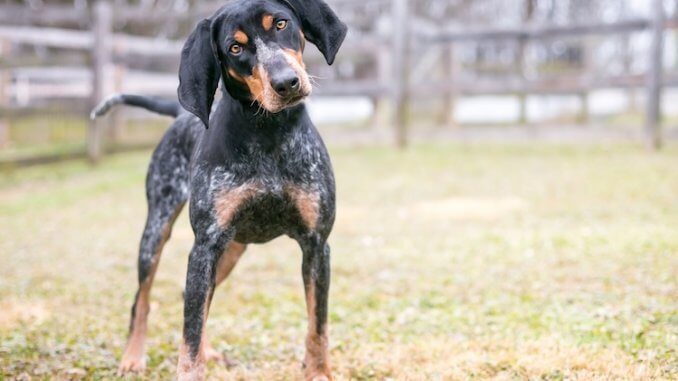
The Bluetick Coonhound is a large dog, originally bred as a hunting companion, although more recently is being used as a loving family pet.
Whilst being able to suit the life of a working dog hunting prey, they are also well-suited to the family home, boasting a range of loveable characteristics such a playfulness, intelligence and affection.
Blueticks are one of a few breeds capable of expressing a sound known as ‘baying’.
This is a beautiful-looking dog breed, which when combined with their loveable characteristics, makes for an excellent companion.
Let’s take a look at everything you should know about the Bluetick Coonhound covering: where they came from, what they require to be happy and healthy and how to buy one of these dogs.
TABLE OF CONTENTS
Bluetick Coonhound Breed Overview
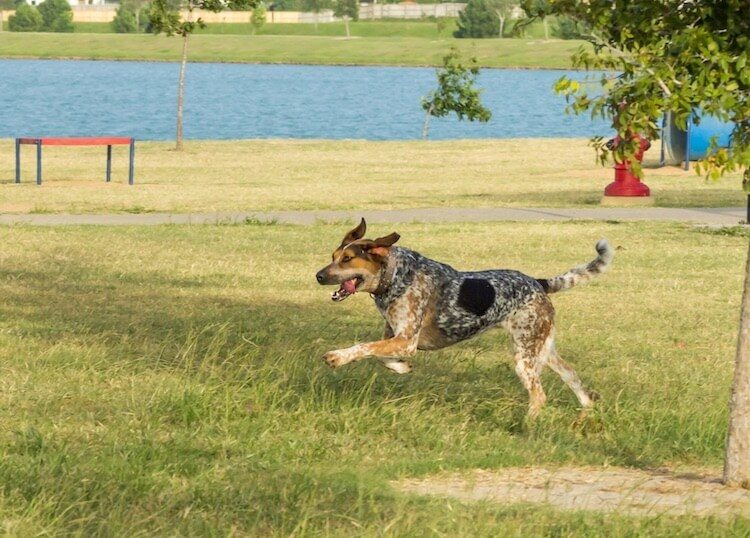
The Bluetick Coonhound is an intelligent and athletic dog; with an instinctively strong prey drive which needs to be channeled.
This prey drive comes from Blueticks originally being bred to hunt racoons (hence the term ‘coonhounds’), though their natural skill at following trails of small mammals does make them ill-suited to a family home.
Although they are commonly used as a hunting companion, many owners have expressed their love for Bluetick Coonhounds as a companion dog.
Loving, loyal and affectionate, Bluetick Coonhounds have been acknowledged for their ability to fit in as part of the family within their home – often curling up at their owner’s feet after their day’s exploring.
Breed Origin
When European settlers came over to America, many hound dogs were mixed to create different breeds which were suitable for the new terrains and climates that they would need to hunt in.
Specifically, The Bluetick Coonhound originated from Louisiana and was bred from a few different breeds:
- French Bleu de Gascogne Hound
- English Foxhound
- American Foxhound
- Black and Tan Virginia Foxhound
They were originally bred to hunt racoons although their prey can be extended to other mammals, such as bobcats, opossums and even cougars.
Unlike foxhunting, owners do not move with the dogs but wait until they hear the Bluetick baying and howling to signal that they have found the prey.
Blueticks are therefore very adapted to be a hunting companion due to their previously mentioned acute sense of smell and unique ‘cold noses’, as well as their muscular body and athleticism.
These hunting skills have meant they have been historically bred, and continue to be bred as, loyal hunting companions, although this loyalty and affection now means they are also commonly kept as family pets too.
Kennel Club Recognition and Pedigree
They were recognized by the United Kennel Club as a separate breed in 1946 and are also recognized by the Australian National Kennel Club and the New Zealand Kennel Club.
They also became accepted by the American Kennel Club in 2009.
Bluetick Coonhounds are classified as part of the hound group, and more specifically are known as scent hounds for their acute sense of smell.
Their ‘cold noses’ also mean they are particularly skilled at being able to trace a trail even if it is a few days old.
This incredible sense of smell combined with their loyalty and trainability makes Bluetick Coonhounds efficient hunting companions.
| Size | 22-17 inches (male) and 21-25 inches (female) |
| Weight | 55-80 pounds (male) and 45-65 pounds (female) |
| Lifespan | 10-12 years |
| Breed Type | Hound |
| Purpose | Hunting Dog |
| Suitable For | Families, Active Adults, Hunters |
| Color Variations | Dark Blue, Densely Spotted With Black Flecks With Black (And Sometimes Tan) Head And Ears |
| Temperament | Athletic, Driven, Intelligent, Energetic, Affectionate |
| Other Names | n/a |
Bluetick Coonhound Puppies
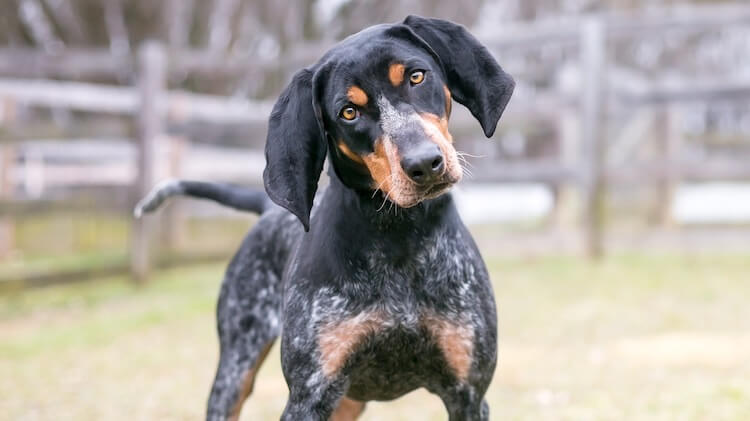
The Bluetick Coonhound is one of the few breeds considered to be ‘made in the USA’.
Litters usually consist of around 6-8 puppies, and a Bluetick Coonhound puppy normally costs between $500-$600 USD.
Each puppy will typically weigh between 7-8 pounds at seven weeks of age (when they are ready to go to their new homes).
As they are a larger dog breed, Blueticks should mature to their full-size between 15-18 months old and reach their full adult weight by two years.
| Weight (lb) | |
| 3 | 12 |
| 6 | 29 |
| 9 | 39 |
| 12 | 52 |
Bluetick Coonhound Temperament
The Bluetick Coonhound has a strong prey drive, which will need to be managed to ensure they are sufficiently stimulated and exercised to maintain a happy and healthy dog.
Being bred as a hunting companion, a Bluetick dog has lots of energy and stamina.
They also have a keen natural instinct to pursue interesting scents and so, for that reason, it is essential that they are housed in an area with a secure backyard.
Compatibility with Families
Their intelligence and high energy levels means they are very playful.
As they are very social with other dogs (as well as humans), any play involving dog or human interaction is ideal for Bluetick dogs.
Their loyalty to their owner means any interactive play such as fetch, or chase is ideal in strengthening that bond between dog and owner.
Whilst being very loving and loyal to their owners, they are also very friendly and sociable to other dogs as well as children.
However, due to their size, they are probably better suited to older children as they can be quite boisterous when excited.
They may also be less suited to homes with cats or other small mammals due to their instinctive prey drive.
However, if they have been raised as a family pet (with cats already in the home) and had appropriate training to prevent them from chasing cats, then they are more likely to adapt.
Bluetick Coonhound Personality
Because this dog is from the hound group, they can be quite vocal by barking and howling when excited.
Interestingly, the Bluetick Coonhound can also produce another sound called ‘baying’ (remember we mentioned this in the introduction).
Specific to only a select number of breeds, baying is a unique sound somewhere in between howling and barking.
This is the sound Blueticks would produce during a hunt to announce the location of the prey and is sometimes produced in pet Blueticks exhibiting guarding behavior.
Whilst it may be music to the ears of hunters, it may be something that potential owners should have a listen to first to ensure they are prepared for their dog to make this unusual noise.
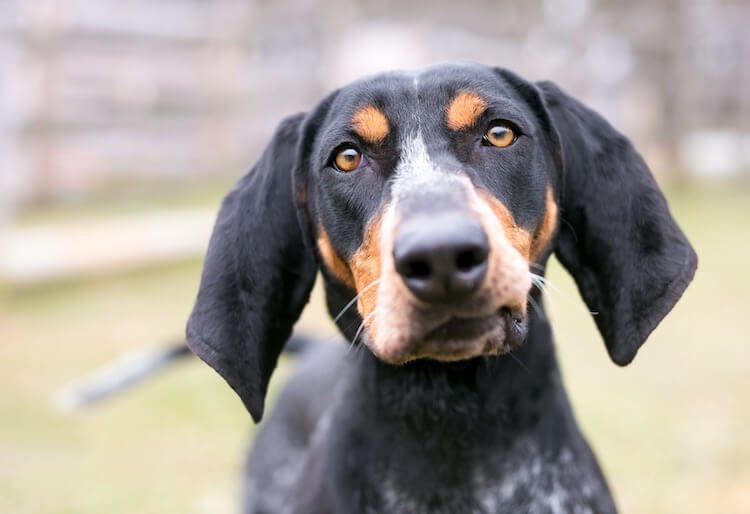
From Adobe Stock
Overall, the Bluetick Coonhound is an intelligent breed, devoted to their owners and great lovers of exercise and play.
They suit the lifestyle of a driven and focused hunting companion whilst remaining sociable and friendly to other dogs and children which makes them a suitable family pet.
Bluetick Coonhound Size, Appearance and Grooming
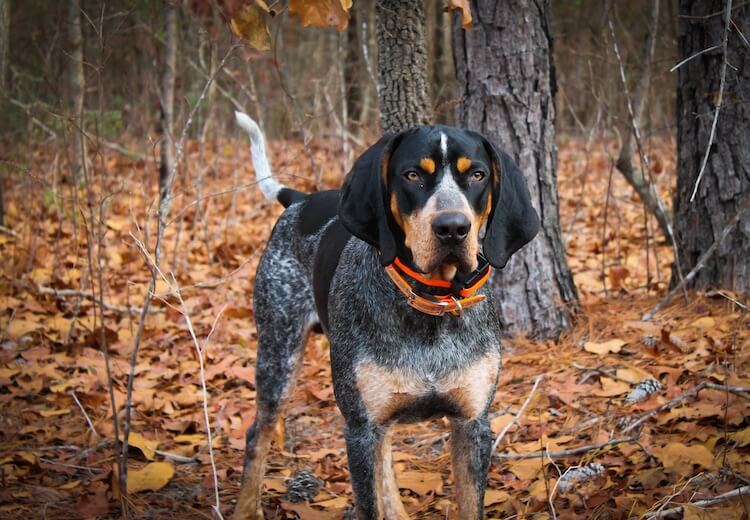
Bluetick Coonhound Full Grown
Bluetick Coonhounds are a large breed with males weighing between 55-80 pounds, and females being typical smaller, between 45-65 pounds.
The average height of a male is between 22-27 inches with females being around 21-25 inches tall (to the withers).
Bluetick Coonhound Appearance
The head and ears of the Bluetick Coonhounds are black, although can sometimes have tan markings over the eyes, ears and cheeks too.
Their body is thickly mottled, predominantly with blue ticking although red ticking can occur on the chest and legs.
Color Types
Bluetick Coonhounds have a single coat which is very short, dense and glossy.
As the coat is so dense, they will malt all year round, though the shed will only be moderate and so they require less maintenance than longer-coated breeds.
Grooming Guide
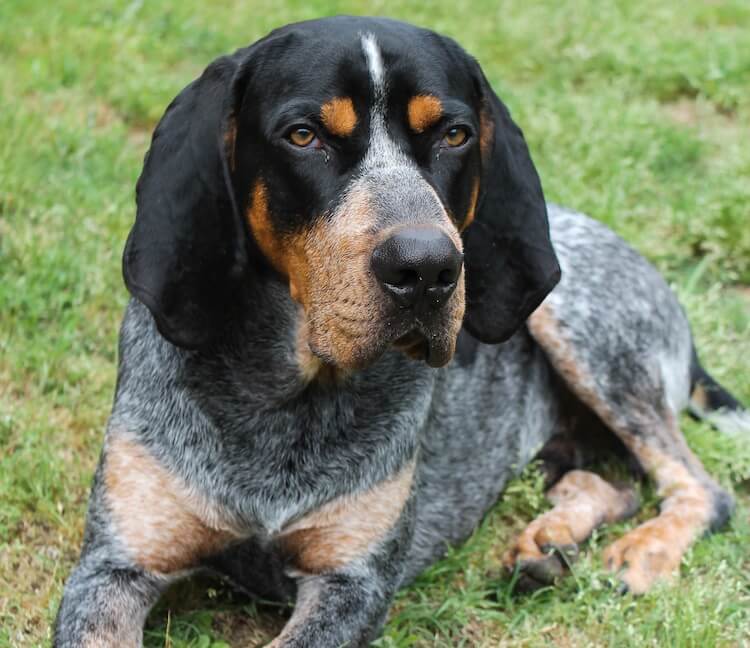
From Adobe Stock
As a result of their short coat, brushing needs to occur only weekly with a rubber mitt, medium bristly brush or a hound mitt to remove any excess or loose hair.
This breed can usually be seen charging through undergrowth following scents, they should obviously be bathed when necessary if they have been rolling around in anything mucky!
Their love for exploring in undergrowth will also mean regular checks for ticks on their face and body after each walk so they can be removed promptly and safely.
Scent hounds are also known to be prone to a musty ‘hound odor’ which potential owners may want to bear in mind, though this can be managed by regular bathing if required.
Full grooms will only need to be done occasionally to tidy up their coat and clip away any areas where excess hair may have grown.
Additionally, as with any dog breed, the Bluetick Coonhound will need regular monitoring of their nails to ensure they do not grow too long and become uncomfortable.
Care Guide
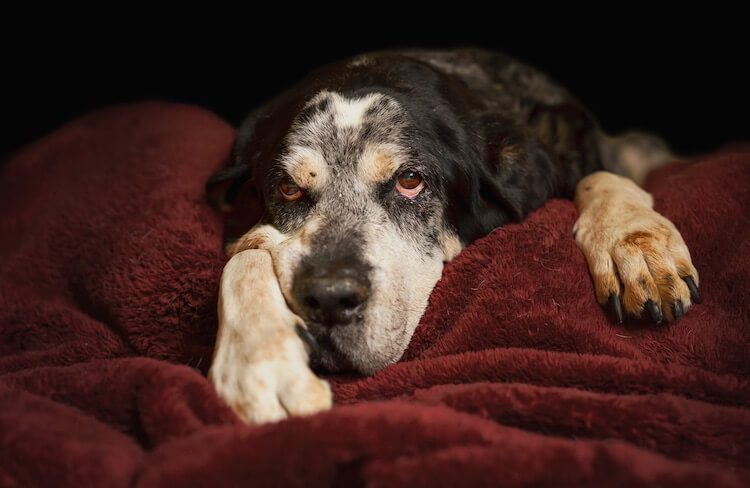
The Bluetick Coonhound is a relatively easy dog breed to care for.
As long as they get their exercise requirements (so they can expend all their energy and not become bored) they make an excellent addition to the family.
Food and Dietary Requirements
| Daily Food Consumption | |
|---|---|
| Guide | 1,400 calories |
| Cups of Kibble | From Adobe Stock |
Feeding this dog is not complicated, they only require a good-quality kibble and additional nutrients are not necessary if they are a family pet.
Blueticks should be fed twice a day (once in the morning and once in the evening) on high quality kibble to maintain protein levels.
If they work as hunting dogs, they may require more protein in their diet to keep up with the energy they need when chasing prey. To make sure that your hunting dogs get the nutrients they need for their active lifestyle, you may choose to include diet foods designed specifically for hunting dogs.
Larger kibble specifically formulated for larger sized dogs is preferable.
Snuffle mats and puzzle feeders are also a great way to keep them mentally stimulated and prevent boredom when they are alone if you ever have to pop out for a while.
Depending on the type of kibble you are feeding, Coonhounds will require around 380 grams/day, although this will depend on the brand of kibble (each food will contain guidelines on the pack suggesting the amount to feed your dog depending on their weight).
On a daily basis, nutritional requirements for an average size (60 pound) Bluetick with normal activity levels include around 13% of their kibble being fat and around 25% to be protein with daily calorie intake equating to around 1,400 calories a day.
Exercise Requirements
| Daily Exercise Requirements | |
|---|---|
| Minutes | 60 minutes |
| Activity Level | From Adobe Stock |
Characteristically, a Bluetick Coonhound will have strong sense of smell which means they can typically be found with their noses close to the ground following varying scent trails.
This natural instinct means the breed are very fast and active with a strong prey drive.
Because of this, your dog will need to be walked for around an hour a day minimum. Not enough exercise can lead to Blueticks becoming bored and subsequently destructive.
Exercising them off-lead is great for letting them run around, chase and burn lots of energy, however it may be best to reserve off-leash exercise for enclosed spaces to avoid them pursuing some interesting scent trails which may lead to them wondering off.
Walks on the leash are most appropriate for this breed through a forest or in open areas.
Any places with many interesting smells to stimulate their olfactory system, and ensure they are worn out at the end of the walk, are great!
Longer leashes are preferable to allow them that extra room to have a wonder and follow their noses without taking off.
Walks enable them to explore their surroundings thoroughly but should be combined with the occasional run a couple of times a week to ‘let go’ and burn off some energy.
Bluetick Coonhound Training

From Adobe Stock
As with any dog, the socialization period between 8-16 weeks is crucial for exposing puppies to other dogs of varying breeds and sizes; strangers; young and older children; bicycles; cats and as much as possible!
This is to expose them to as much of the world as you can and is a vital part of their development to ensure they take on those typical breed characteristics of a sociable, affectionate dog.
Exposure to cats, and other small mammals, whilst preventing the puppy from chasing is essential if owners are looking for a family dog with a dampened prey instinct.
As with any dog breed, a fair amount of effort is required for training (even if the breed is intelligent).
Recall is an especially important concept to train as soon as possible to ensure they return back to their owner if they have picked up the scent of something more interesting!
Positive reinforcement is well-suited to this breed using food-based rewards as their acute sense of smell will be able to identify the food instantly.
Lots of mental stimulation is required so hide and seek games where they have to sniff out their owners in a field or find treats around the house are an ideal way of utilizing their keen sense of smell.
Known Health Problems
As with many large breeds, hip and elbow dysplasia is common, and very prolific among Bluetick Coonhounds in particular.
This occurs when there is a problem in the formation of the hip or elbow socket which can cause painful arthritis and cause some dogs to go lame.
Unfortunately, it is incurable and usually genetic, but steps can be taken to alleviate symptoms. These include:
- Weight management
- Exercise control
- Massage
- Medication to reduce pain
They can also be very food-driven, so are at risk of excessive weight gain if they are allowed to over-eat, are fed too many treats or are under exercised.
As they were originally bred in packs, they would have to eat as much as they could as quickly as possible which has led to this tendency to eat excessively.
Bluetick Coonhound Summary
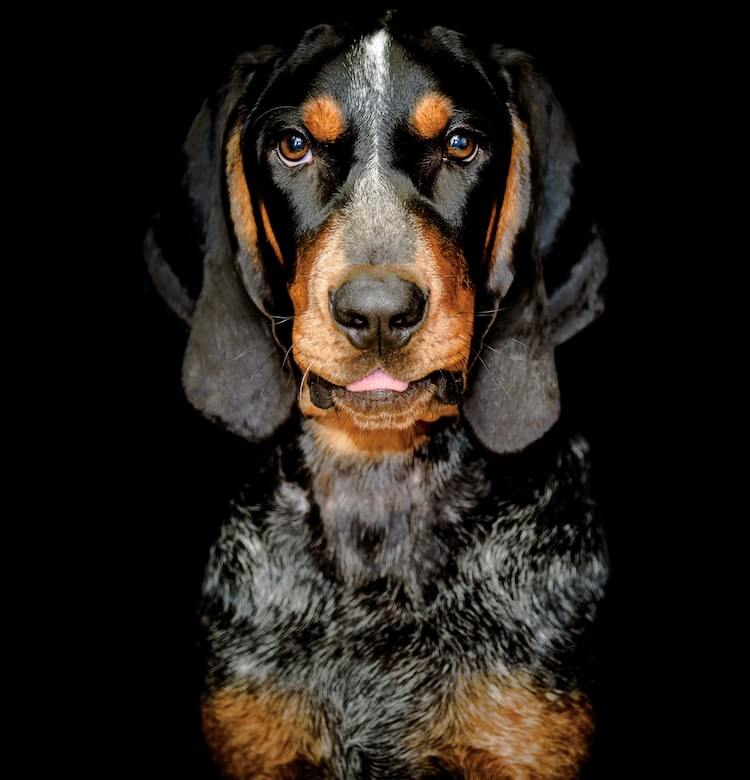
From Adobe Stock
The Bluetick dog is an active, intelligent breed requiring lots of mental stimulation and exercise.
Like most dogs, moderate effort will need to be made with training, especially recall, but the rewards the owner will gain in return are priceless.
A loyal, affectionate hound, suitable to new owners, as a family pet, or as a hunting companion who utilizes their hunting skills in which they were bred for.
Their loving temperament and playful personality mean this well-loved breed will be the perfect companion for any prospective dog owner looking for an active best friend to explore the outdoors with.
Do you think the Bluetick Coonhound could be your new best friend? Let us know in the comments below.


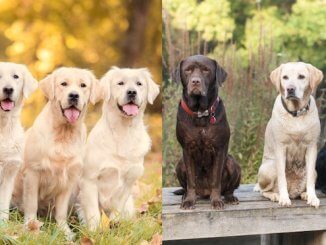
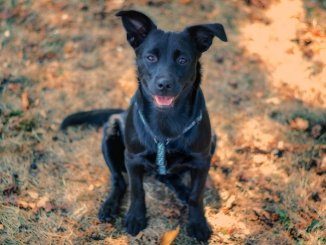
Be the first to comment